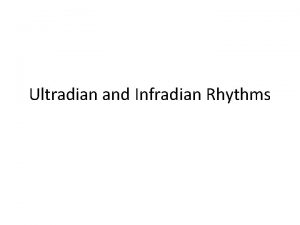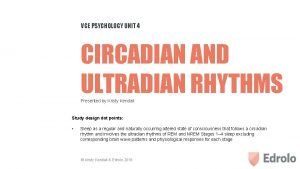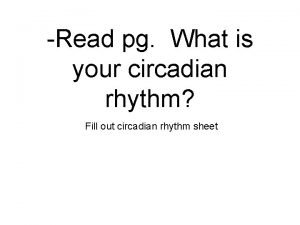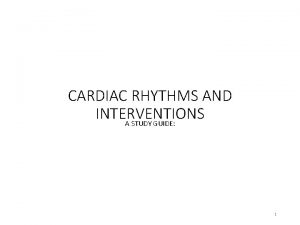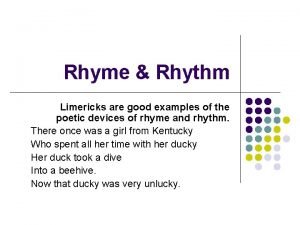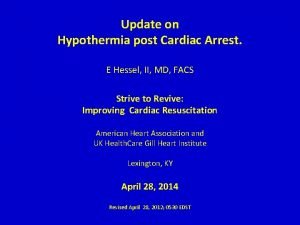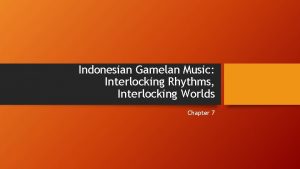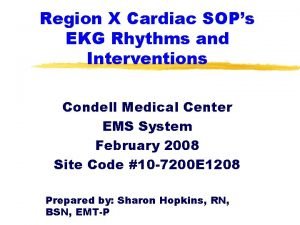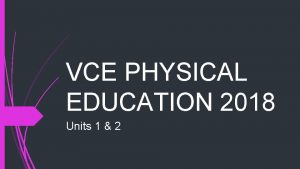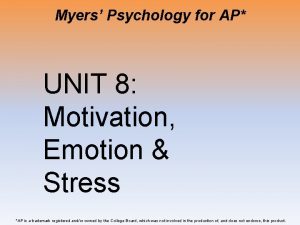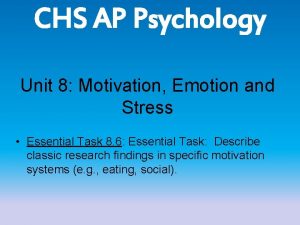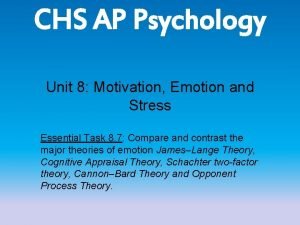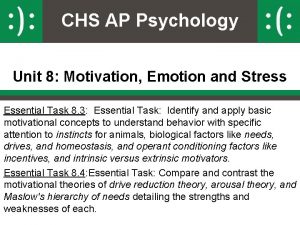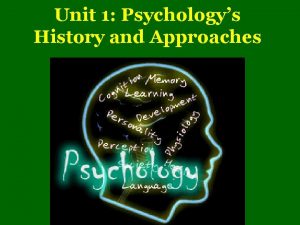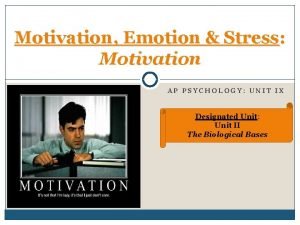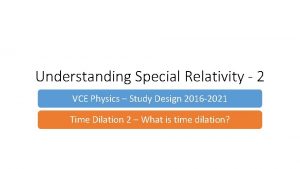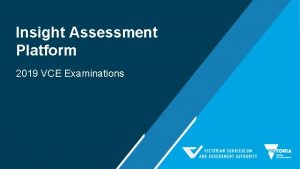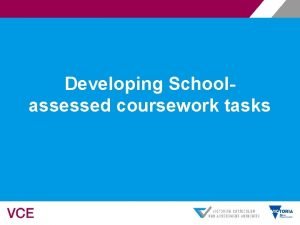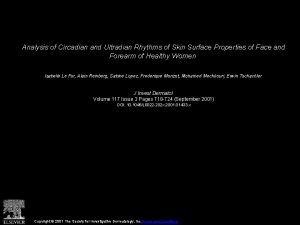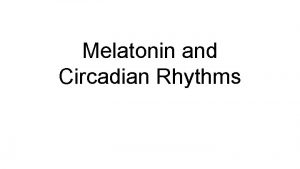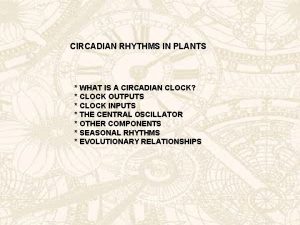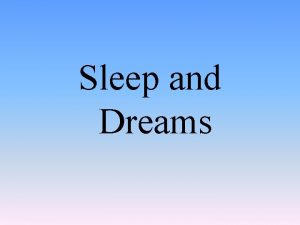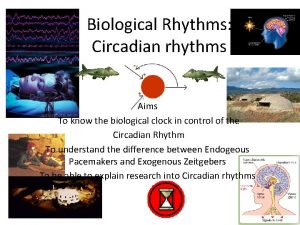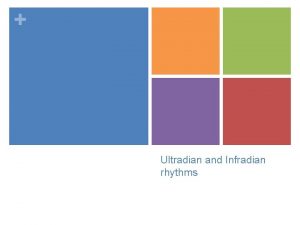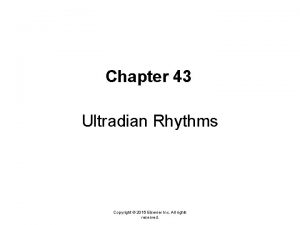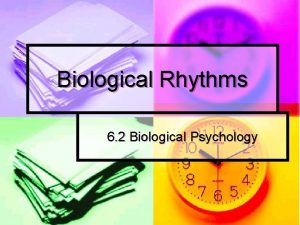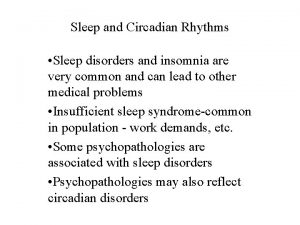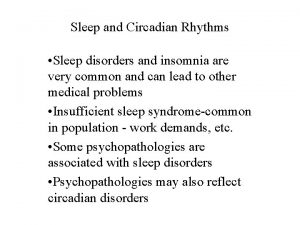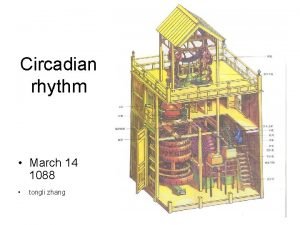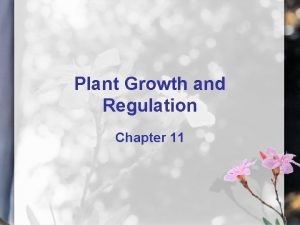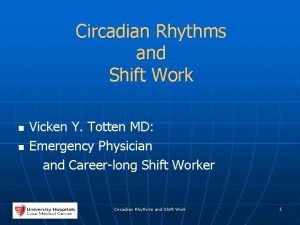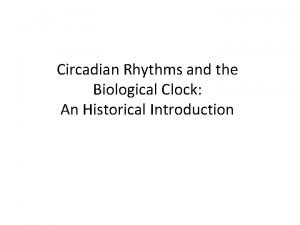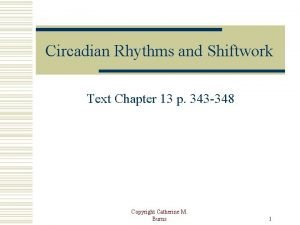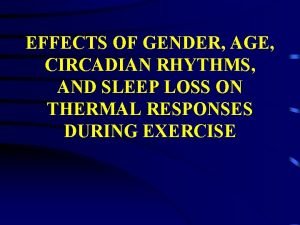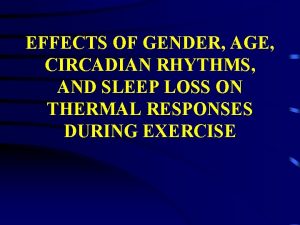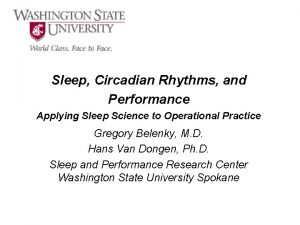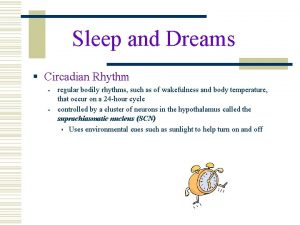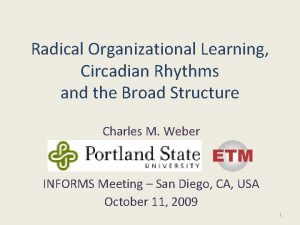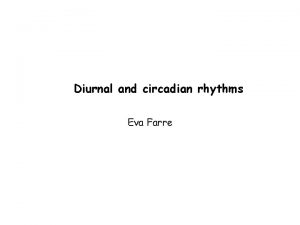VCE PSYCHOLOGY UNIT 4 CIRCADIAN AND ULTRADIAN RHYTHMS
















































- Slides: 48

VCE PSYCHOLOGY UNIT 4 CIRCADIAN AND ULTRADIAN RHYTHMS Presented by Kristy Kendall Study design dot points: • Sleep as a regular and naturally occurring altered state of consciousness that follows a circadian rhythm and involves the ultradian rhythms of REM and NREM Stages 1– 4 sleep excluding corresponding brain wave patterns and physiological responses for each stage © Kristy Kendall & Edrolo 2016

Images used under license from Pixabay © Kristy Kendall & Edrolo 2016

Interesting facts…. • What is the longest someone has slept? If a coma counts…over 30 years • What is the longest someone has gone without sleep? 18 days 21 hours and 10 mins • Which animal sleeps the longest? The brown bat = 19. 9 hours a day • Which animal sleeps the shortest? The giraffe = 1. 9 hours a day © Kristy Kendall & Edrolo 2016 • Being awake for 17 hours is the equivalent of having a BAC of 0. 05 • Scientists are unable to explain a 1998 study that found when a bright light is shone at the back of your knees the sleep-wake cycle resets • You will spend approximately 27 years asleep • Ducks sleep with half an active brain to protect themselves from predators • Elephants stand during NREM but lie down for REM sleep • Lots more for you to read about at…. . http: //www. abc. net. au/science/sleep/fa cts. htm

Sleep as an altered state of consciousness • On average, we spend about one-third of our lives asleep. If you are 17 years old, you have probably spent more than 5. 5 years asleep. A person who is 45 years old has spent about 15 years asleep and someone who is 75 years old has slept for 25 years. • We spend up to one third of our waking time daydreaming, or more than 5 hours per day (1 year every 4. 5 years). Add this up. How many years have you spent sleeping and daydreaming? • To nod off to sleep is to temporarily lose normal waking consciousness, including some awareness of yourself and your environment. © Kristy Kendall & Edrolo 2016

Characteristics of sleep that define it as an ASC Level of awareness: Awareness of internal and external events • Sleep is a unique state of awareness. It is certainly not a period of being awake, nor are we in a coma (unconscious). • We have some, albeit very little, awareness of our external environment when we are asleep. • At times, we may incorporate what is happening around us into a dream or we may suddenly be woken from a deep sleep by something highly personally relevant (such as a parent responding to their baby’s crying). © Kristy Kendall & Edrolo 2016

Content limitations : Amount of control you have to limit what you attend to When we sleep, we do not have conscious control of our thoughts. Everyone dreams and the dreams we remember tend to be bizarre. The contents of our dreams tend to be much broader and deeper than our thoughts in normal waking consciousness. We have no ability to limit what we attend to Controlled and automatic processes: Ability to perform two or more tasks at once, depending on complexity Performing other tasks is mostly impossible. It is interesting to note that most sleepwalkers, known as somnambulists, usually carry out routine, automatic processes when they sleep walk. © Kristy Kendall & Edrolo 2016

Perceptual and cognitive distortions: Degree of awareness, and efficiency of your perceptions and cognitions Our attention to and perception of sensory stimuli is lowered during sleep, including our perception of pain. Our thoughts (cognition) are more likely to be disorganized and unrealistic during our dreams. Emotional awareness: Experience of emotions (feelings) Our emotions can be more or less intense or flattened during sleep. A nightmare can make us feel very scared and a good dream can make us feel terrific. There is some evidence that sleep can help us deal with our emotions Self-control: Ability to maintain self-control Our ability to maintain self-control, including monitoring our own behaviour, is lowered during sleep. For instance, we may snore, grind our teeth or talk during our sleep © Kristy Kendall & Edrolo 2016

Time orientation: Ability to correctly perceive the speed at which time passes Our ability to perceive the speed at which time passes may be affected. Time can seem to fly and, on other nights, it can feel as if it takes forever to reach the morning. Despite this, there is growing evidence that suggests we have the ability to estimate the amount of time that has elapsed during sleep (Aritake. Okada et al, 2009). Often, we are able to wake up at a predetermined time without the use of an alarm clock. It appears that the ability to estimate time is associated with our deep (Stages 3 and 4 NREM sleep) sleep and is more likely when we follow a regular sleep routine, including going to bed at the same time each night. © Kristy Kendall & Edrolo 2016

Characteristics and patterns of sleep • Sleep is not just one state of consciousness; it comprises a number of predictable states and follows a highly organized sequence of events. • Throughout sleep, our bodies shift through a number of stages, each with its own unique characteristics. The different stages of sleep are usually identified by measurable changes in physiological responses • Physiological changes include changes in brainwave patterns, muscle tension, eye movement, body temperature, heart rate, blood pressure, respiration and hormone release. © Kristy Kendall & Edrolo 2016

Biological rhythms • • Circadian rhythms – physical, mental and behavioural patterns that follow a 24 hour cycle. Largely relate to light and dark cycles. – eg Sleep-wake cycle © Kristy Kendall & Edrolo 2016

Biological rhythms • Ultradian rhythms • • – recurrent cycle that is repeated within a 24 hour cycle (ie less that 24 hours) • eg REM/NREM cycle Some studies show merit to doing many things in 90 minute cycles Infradian rhythms – recurrent cycle in longer periods than 24 hours • eg menstrual cycle © Kristy Kendall & Edrolo 2016

Sleep and circadian rhythms (24 hour rhythms) • Our bodies are attuned to a sleep–wake cycle that revolves around night and day. This regular cycle, an example of a circadian rhythm (see Table 14. 1), is determined by an internal body clock (the suprachiasmatic nucleus) located in the hypothalamus in the brain. • Levels of arousal, hormone secretions, metabolism, heart rate and body temperature are influenced by this clock. • For most people, the circadian cycle peaks (awake and alert) during the day (usually the afternoon), with the lowest point being early in the morning (drowsy and sleepy). BIOLOGICAL RHYTHM LENGTH OF CYCLE EXAMPLES Circadian rhythms 24 hours > Sleep–wake cycle > Alertness > Body temperature > Growth hormone secretion Ultradian rhythms Less than 24 hours > REM and NREM sleep cycles Infradian rhythms © Kristy Kendall & Edrolo 2016 More than 24 hours • > Migration patterns of some animals • > Seasonal variations in mood and appetite

© Kristy Kendall & Edrolo 2016 Hormones including cortisol and melatonin are regulated by the suprachiasmatic nucleus. Cortisol levels link with our level of alertness, with higher levels associated with greater alertness. Melatonin, a sleep hormone, causes sleepiness and is released when it is dark. It is secreted from a small structure in the brain called the pineal gland. Light stops melatonin secretion and therefore light can prevent sleepiness. Adrenalin is also involved, influencing such properties as blood pressure and heart rate.

• our sleep–wake cycle is largely endogenous, meaning it is based on internal biological factors. However, external (environmental) cues, such as light and dark, partially in uence the sleep–wake cycle. Such cues are known as zeitgeners. • Light sensors in our eyes (and even the back of our knees!) inform our brain when it is light, which then adjusts our internal body clock accordingly. This means detection of light is the primary external signal for the suprachiasmatic nucleus. The suprachiasmatic nucleus then signals to the pineal gland to stop the release of melatonin, the hormone responsible for making us sleepy. • Exposure to light at different times in the day has di erent e ects. Early morning light can cause a phase shift, leading to waking. Light in the middle of the day does not affect us too much. Light in the evening, however, causes a phase delay by keeping us awake (preventing us from sleeping). © Kristy Kendall & Edrolo 2016

Sleep and ultradian rhythms (less than 24 hrs) • Throughout sleep, we shift between non-rapid eye movement (NREM) and rapid eye movement (REM) sleep • The primary distinguishing feature between NREM and REM sleep is that rapid eye movement occurs in REM sleep. When investigated further, however, there are other physiological and psychological differences between the two. • The NREM/REM cycle is an example of an ultradian rhythm a biological rhythm that is shorter than 24 hours. © Kristy Kendall & Edrolo 2016

A typical nights sleep • Approximately 7 -8 hours per night • 1. 5 hour cycles. On average, we go through one cycle of NREM and REM every 90 minutes • Most adults typically experience four to six NREM/REM cycles per night. • NREM periods decrease as the night progresses • REM periods increase as the night progresses • This means that we typically spend more time in REM sleep in the cycle just before we wake in the morning compared to cycles earlier in the night. Images used under license from Pixabay © Kristy Kendall & Edrolo 2016

Hypnogram © Kristy Kendall & Edrolo 2016

NON–RAPID EYE MOVEMENT SLEEP • Once asleep, we enter NREM sleep consists of four stages and accounts for about 80 per cent of our total sleep time. Stage 1 NREM sleep • During the transition from being awake to being asleep, or falling asleep, we enter a relaxed state known as a hypnogogic state. During this state, we may experience hallucinatory images, such as flashes of light and vivid images. Hypnogogic (hypnic) jerks – involuntary muscle twitches that cause us to jolt – are common. • When falling asleep, usually at the beginning of the night as your muscles relax, have you ever felt like you were falling and woken with a jump? The hypnogogic state is often considered to be part of Stage 1 NREM sleep. © Kristy Kendall & Edrolo 2016

Stage 2 NREM sleep • Many consider the start of Stage 2 NREM sleep as the point at which true sleep begins. • We spend about 20 minutes in Stage 2 NREM sleep in our first NREM/REM sleep cycle and it is still fairly easy to be woken up at this stage, despite it being a deeper stage of sleep. If we are woken, it is likely that we still won’t believe we were asleep. • As we slip further into Stage 2 NREM sleep, our eyes stop rolling, our muscles become further relaxed and our breathing and heart rate continues to decrease. • Stage 2 NREM sleep accounts for about 50 per cent of our total sleep. © Kristy Kendall & Edrolo 2016

Stage 3 NREM sleep • Stage 3 NREM sleep is a brief transitional stage that marks the start of deep sleep. During Stage 3 NREM sleep, we become less responsive to external stimuli and more difficult to awaken. • If we are woken from Stage 3 NREM sleep, we feel very groggy and disorientated. • In Stage 3 NREM sleep, our eyes do not move, our muscles are relaxed and heart and breathing rates continue to become slower and more regular. Stage 4 NREM sleep • Stage 4 NREM sleep is the deepest sleep and, as in Stage 3 NREM sleep, it is extremely difficult to wake someone who is in this sleep stage. This is when we are ‘fast asleep’ or ‘sleeping like a log’. Although our level of conscious awareness is very low, we can still be sensitive to certain stimuli, such as a baby crying or a smoke alarm. • In the first NREM/REM sleep cycle, we spend about 30 minutes in Stage 4 © Kristy Kendall & Edrolo 2016 NREM sleep and it has probably been about an hour since we first fell asleep.

Rather than remaining in Stage 4 NREM sleep, we quickly cycle back through the sleep stages: Stage 4 NREM to Stage 3 NREM to Stage 2 NREM, then skipping Stage 1 NREM and going straight into REM sleep. Wake up feeling great! Video source: https: //www. youtube. com/watch? v=Ewajc 2 e. XZr 0 © Kristy Kendall & Edrolo 2016

RAPID EYE MOVEMENT SLEEP • As the name suggests, rapid eye movement (REM) sleep is a period of sleep when your eyes move rapidly, for short bursts of time. • The first cycle of REM sleep lasts for about 10 minutes. • REM sleep is a lighter sleep than Stages 3 and 4 NREM sleep and therefore easier to wake from. Unlike NREM sleep, if we are woken during REM sleep, we are likely to report that we were dreaming. This is true for everyone, even those who say they don’t usually dream. • During REM sleep there are marked physiological changes - repetitive bursts of rapid eye movement, and heart rate, blood pressure and respiration increase and fluctuate. Body temperature tends to match the surrounding environment and genitals are aroused. • However, no muscle tension – the muscles that move voluntarily, especially those below the neck, are very relaxed to the point of being almost paralysed (except for the occasional twitching). This paralysis is known as muscle atonia or cataplexy. © Kristy Kendall & Edrolo 2016

• Referred to as paradoxical sleep. This is because the body can appear calm on the exterior (virtually no muscle activity) but other bodily systems and the brain are highly active, having many features that are similar to being awake. • It appears that most dreaming occurs during REM sleep. Dreams during REM sleep tend to follow a storyline (though a bizarre one at times) and the dreamer often feels as if they are experiencing a different world. The final dream of the night tends to be the longest, strangest and most exciting – elements that make it more likely to be remembered. Therefore, the dreams you remember and repeat to other people are most likely to be your last REM dreams in the night. In reality, though, we remember very few of our dreams. Can you remember the four or five dreams you had last night? You probably spent about 2 hours dreaming. That adds up to about 6 years of dreaming in a lifetime. • People who are lighter sleepers and people who are anxious are more likely to dream in NREM sleep. Have you ever felt as if you have been awake all night thinking about a problem? The chances are that you did sleep and some of this thinking occurred during an NREM dream. © Kristy Kendall & Edrolo 2016

REM vs NREM sleep • We spend approximately 80% of our sleep time as adults in NREM and only 20% in REM • Each type of sleep is characteristically different and has contrasting features and functions © Kristy Kendall & Edrolo 2016

Distinguishing between types of sleep REM EOG EEG EMG Physiological responses Presence of dreams Timing in night Percentage of sleep Necessary for © Kristy Kendall & Edrolo 2016 NREM

Dreams • What are dreams? • What is their purpose? • Who dreams and when? • Colour/length and content of dreams? • What is lucid dreaming? Images used under license from Pixabay © Kristy Kendall & Edrolo 2016

Stages of NREM sleep © Kristy Kendall & Edrolo 2016

Stages of NREM sleep Brainwaves Stage 1 (NREM) Stage 2 (NREM) Stage 3 (NREM) Stage 4 (NREM) © Kristy Kendall & Edrolo 2016 Duration Physiological responses Special features

Special features • Hypnogocic state • Hypnic jerk • Sleep spindle • K complex • Slow wave sleep • Hypnopompic state © Kristy Kendall & Edrolo 2016

Special brain waves Images used under license from Wikipedia Commons © Kristy Kendall & Edrolo 2016

Multiple choice activity Johnny fell asleep during his English class. His arm twitched and he woke up suddenly. Johnny was most likely in A. rapid eye movement (REM) sleep. B. stage 1 non-rapid eye movement (NREM) sleep. C. stage 2 NREM sleep. D. stage 3 NREM sleep. © Kristy Kendall & Edrolo 2016 (VCAA 2015 Exam Q 10)

Multiple choice response Johnny fell asleep during his English class. His arm twitched and he woke up suddenly. Johnny was most likely in A. rapid eye movement (REM) sleep. B. stage 1 non-rapid eye movement (NREM) sleep. C. stage 2 NREM sleep. D. stage 3 NREM sleep. © Kristy Kendall & Edrolo 2016 (VCAA 2015 Exam Q 10)

Multiple choice activity Megan was in non-rapid eye movement (NREM) stage 2 sleep when her alarm rang at 6 am. She woke up instantly, refreshed and ready for the day. If Megan were attached to an electroencephalograph (EEG), which of the following changes to her brain waves would be likely to be observed when she woke up compared to just before waking? A. an increase in frequency and a decrease in amplitude B. a decrease in frequency and an increase in amplitude C. no change in amplitude D. no change in frequency © Kristy Kendall & Edrolo 2016 (VCAA 2014 Exam Q 14)

Multiple choice response Megan was in non-rapid eye movement (NREM) stage 2 sleep when her alarm rang at 6 am. She woke up instantly, refreshed and ready for the day. If Megan were attached to an electroencephalograph (EEG), which of the following changes to her brain waves would be likely to be observed when she woke up compared to just before waking? A. an increase in frequency and a decrease in amplitude B. a decrease in frequency and an increase in amplitude C. no change in amplitude D. no change in frequency © Kristy Kendall & Edrolo 2016 (VCAA 2014 Exam Q 14)

Multiple choice activity If Megan’s alarm had rung after she had been asleep for only a couple of hours, it is likely that A. she would wake easily as she would still be in the first sleep cycle. B. it would be difficult to wake her as she is likely to be in NREM stage 1 sleep. C. it would be difficult to wake her as she is likely to be in NREM stages 3 and 4 sleep. D. it would be difficult to wake her as she is likely to be in rapid eye movement (REM) sleep. © Kristy Kendall & Edrolo 2016 (VCAA 2014 Exam Q 16)

Multiple choice response If Megan’s alarm had rung after she had been asleep for only a couple of hours, it is likely that A. she would wake easily as she would still be in the first sleep cycle. B. it would be difficult to wake her as she is likely to be in NREM stage 1 sleep. C. it would be difficult to wake her as she is likely to be in NREM stages 3 and 4 sleep. D. it would be difficult to wake her as she is likely to be in rapid eye movement (REM) sleep. © Kristy Kendall & Edrolo 2016 (VCAA 2014 Exam Q 16)

Fast five: Question 1 How long is one typical sleep cycle? © Kristy Kendall & Edrolo 2016

Question 1 (Response) How long is one typical sleep cycle? Answer: 90 minutes © Kristy Kendall & Edrolo 2016

Fast five: Question 2 In which type of sleep do we experience muscle paralysis? © Kristy Kendall & Edrolo 2016

Question 2 (Response) In which type of sleep do we experience muscle paralysis? Answer: REM © Kristy Kendall & Edrolo 2016

Fast five: Question 3 What percentage of an adult’s night sleep is typically spent in NREM? © Kristy Kendall & Edrolo 2016

Question 3 (Response) What percentage of an adult’s night sleep is typically spent in NREM? Answer: 80% © Kristy Kendall & Edrolo 2016

Fast five: Question 4 An involuntary muscle twitch in Stage 1 sleep is known as what? © Kristy Kendall & Edrolo 2016

Question 4 (Response) An involuntary muscle twitch in Stage 1 sleep is known as what? Answer: Hypnic jerk © Kristy Kendall & Edrolo 2016

Fast five: Question 5 A sleep spindle is a bust of high _____ brainwaves? © Kristy Kendall & Edrolo 2016

Question 5 (Response) A sleep spindle is a bust of high _____ brainwaves? Answer: Frequency © Kristy Kendall & Edrolo 2016

VCE PSYCHOLOGY UNIT 4 CIRCADIAN AND ULTRADIAN RHYTHMS Presented by Kristy Kendall Study design dot points: • Sleep as a regular and naturally occurring altered state of consciousness that follows a circadian rhythm and involves the ultradian rhythms of REM and NREM Stages 1– 4 sleep excluding corresponding brain wave patterns and physiological responses for each stage © Kristy Kendall & Edrolo 2016

The copyright in substantial portions of this material is owned by the Victorian Curriculum and Assessment Authority. Used with permission. The VCAA does not endorse this product and makes no warranties regarding the correctness or accuracy of its content. To the extent permitted by law, the VCAA excludes all liability for any loss or damage suffered or incurred as a result of accessing, using or relying on the content. Current and past VCAA exams and related content can be accessed directly at www. vcaa. vic. edu. au We do our best to make these slides comprehensive and up-to-date, however there may be errors. We'd appreciate it if you pointed these out to us!
 Ultradian rhythms examples
Ultradian rhythms examples Hypnogocic
Hypnogocic Circadian rhythm
Circadian rhythm Feelings in a dream chapter 7
Feelings in a dream chapter 7 Jones and bartlett ekg strips
Jones and bartlett ekg strips Example of rhythm
Example of rhythm Shockable and nonshockable rhythms
Shockable and nonshockable rhythms Shockable and nonshockable rhythms
Shockable and nonshockable rhythms Gamelan indonesia rhythm
Gamelan indonesia rhythm Ekg rhythms
Ekg rhythms Rwi fred fingers
Rwi fred fingers Vce psychology study design
Vce psychology study design Edrolo psychology
Edrolo psychology Vce psychology scientific poster
Vce psychology scientific poster Vce literature
Vce literature Vce physics unit 1 and 2
Vce physics unit 1 and 2 Unit 6 review questions
Unit 6 review questions Live it up vce physical education
Live it up vce physical education New vce english study design 2023
New vce english study design 2023 Media codes and conventions vce
Media codes and conventions vce Visual communication design study design
Visual communication design study design Religion and society vce
Religion and society vce Vce chinese language culture and society
Vce chinese language culture and society Positive psychology ap psychology definition
Positive psychology ap psychology definition To a social psychologist a perceived incompatibility
To a social psychologist a perceived incompatibility Fundamental attribution error ap psychology
Fundamental attribution error ap psychology Psychology studies
Psychology studies Social psychology is the scientific study of
Social psychology is the scientific study of Health psychology definition ap psychology
Health psychology definition ap psychology Bulimia nervosa definition ap psychology
Bulimia nervosa definition ap psychology Unit 8 motivation and emotion
Unit 8 motivation and emotion Ap psychology unit 8 test
Ap psychology unit 8 test Ap psychology unit 8 motivation emotion and stress
Ap psychology unit 8 motivation emotion and stress The 7 approaches to psychology
The 7 approaches to psychology Yerkes dodson law ap psychology example
Yerkes dodson law ap psychology example Vce argument analysis
Vce argument analysis Drama vce study design
Drama vce study design Vce statement of results
Vce statement of results Vcaa music performance
Vcaa music performance Vce it
Vce it Extended investigation
Extended investigation Drama conventions vce
Drama conventions vce Physics study design
Physics study design Vce biology poster
Vce biology poster Vcaa scientific poster
Vcaa scientific poster English language study design
English language study design Insight assessment platform
Insight assessment platform Dispositivo a semiconduttore
Dispositivo a semiconduttore Vce assessment principles
Vce assessment principles
